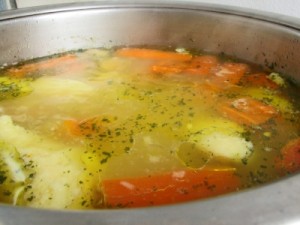Considering fat when cooking stock
There are two special “techniques” for stock that concern fat. The first is really more something to remember than to learn: Never allow stocks or soup to boil vigorously. This is a generalization; there are times it will do no harm at all. But once fat is rendered by the heat of the liquid, rapid boiling of stock can cause it to become so thoroughly dispersed in the liquid that it will be difficult to remove it later. This not only makes for a fattier stock, but can also lead to a somewhat greasy-tasting one. To cook stock, bring it just about to a boil, skim off any foam that rises to the top, and then turn the heat down to about medium-low. What you want is a gentle simmer, a few bubbles hitting the surface all the time, or less often, but never a rolling boil. On some stoves it helps to turn the heat down and partially cover the pan at the same time.
 The second technique which is defatting is simple enough, assuming you make your stock a day or two in advance. To remove nearly all the fat from any stock, strain it and then refrigerate it. (If the weather is cold — say 40°F or lower — just set the strained stock outside, covered of course.) When the fat rises to the top and solidifies — as long as a day later, depending on the quantity of stock and the temperature of the storage place — just skim it off with a spoon and discard it (or save it for cooking, especially if it is from chicken).
The second technique which is defatting is simple enough, assuming you make your stock a day or two in advance. To remove nearly all the fat from any stock, strain it and then refrigerate it. (If the weather is cold — say 40°F or lower — just set the strained stock outside, covered of course.) When the fat rises to the top and solidifies — as long as a day later, depending on the quantity of stock and the temperature of the storage place — just skim it off with a spoon and discard it (or save it for cooking, especially if it is from chicken).
Browning Stock
Sometimes, ingredients for stock are roasted before they are cooked. This is done for exactly the same reasons you would brown anything before proceeding with the cooking process: to increase flavor and darken color. Roasted meats and vegetables make a darker, more complex stock, but not necessarily a better one. Those stocks that do not begin with browning are sometimes brighter and cleaner in flavor.
Straining Stock
When you strain a stock and usually through a sieve (a chinois, or china-cap, is best, but almost any large sieve will do), you have two options. If you press on the vegetables and other ingredients you intensify flavors; if you do not your stock will be clearer. I almost always opt for flavor, because to make a soup perfectly clear takes extreme measures that I’m rarely willing to take.
Reducing Stock
The less water a stock contains, the more intense the flavor, and the less room it takes to store. You can easily reduce a stock to the point where you can store the equivalent of twelve cups of stock in an ice cube tray. To use, just pop out the “ice cube” (it’s actually best to pop them all out, then freeze the cubes in a tightly sealed container or plastic bag) and thaw it in a cup of boiling water. Concentrated stock, undiluted, makes a wonderful and very low-fat flavor addition to stir-fries, sauces, and plain steamed vegetables.
Concentrating stock takes time, however. Before beginning, you should strain and defat the stock. At that point, you can boil it down, stirring now and then and keeping an eye on things to prevent burning which can occur when the mixture becomes very thick. And be aware that reducing, for example, a gallon to a quart takes a while which can be up to an hour; if you begin with three or four gallons, the time you’ll need is even longer, of course. To speed the process, use the broadest pot you have, or divide the stock among two or more pots, so more of the liquid is exposed to the air, where it will evaporate more quickly.
Canned Stock and Bouillon Cubes
Canned stock, usually chicken, but sometimes beef and even vegetable is far, far better than nothing, and the right canned stock is far better than the wrong one. Unfortunately, every tasting of canned stocks I’ve attended has come up with different results. I don’t know whether manufacturers change their recipe annually or whether their stocks are subject to inexplicable fluctuations in quality. But to find a good stock, you must taste several, and then lay in a supply of the one you find best. I will offer these pointers, however:
- Low-salt canned stock tends to have more flavor than the “regular” varieties.
- Stock containing MSG should be avoided at all costs.
- Brand names are no guarantee of quality. The best stock I’ve purchased was an off-brand that cost twenty-five cents a can. (Which, incidentally, meant that a gallon cost about three dollars, still more expensive than making decent stock from scratch.)
As for bouillon cubes, forget it. You’re better off with water and a few extra vegetables.
